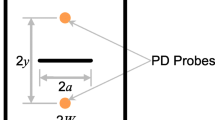Abstract
The paper describes a d-c electric potential system for measuring crack length under thermal/mechanical fatigue-crack-growth (TMFCG) test conditions. A programmable d-c current supply and precision multimeter produce reliable electric-potential readings. H.H. Johnson's formula is used to calculate crack length from electric potential for the center-crack-tensionM(T) geometry. Calibration constants for the formula are determined from an initial optical crack-length measurement. The resolution of the system is 1.0 microvolt which corresponds to a crack extension of approximately 0.002 mm for the center-crack-tension geometry using a current of 10.00 amps. Good crack-length accuracy and low data scatter are achieved by taking special precautions to minimize or eliminate errors in potential measurement due to thermal effects. Material resistivity changes are identified as the cause of short and long term changes in the measured electric potential for uncracked specimens. Crack-length accuracy is discussed in terms of short-term scatter and longterm drift.
Similar content being viewed by others
References
ASTM Special Technical Publication 877, “Automated Test Methods for Fracture and Fatigue Crack Growth,” ed. Cullen, Landgraff, Kaisand, Amer. Soc. Test. and Mat. (1985).
Wei, L.P. and Brazill, R.L., “An a.c. Potential System for Crack Length Measurement,” The Measurement of Crack Length and Shape During Fracture and Fatigue, ed. C.J. Beevers, 190–201 (1980).
Gangloff, R.P., “Electric Potential Monitoring of Crack Formation and Subcritical Crack Growth From Small Defects,”Fatigue of Eng. Mat. and Struct.,4 (1),15–33 (1981).
Van Stone, R.H., Krueger, D.D. and Duvelius, L.T., “Use of a d-c Potential Drop Crack Monitoring Technique in the Development of Defect Tolerant Disk Alloys,” Fracture Mechanics: Fourteenth Symposium-Volume II: Testing and Applications, ASTM STP 791, ed. J.C. Lewis and G. Sines, Amer. Soc. Test. and Mat., II-553 and II-578 (1983).
Marchand, Norman and Pelloux, Regis M., “Thermal-Mechanical Fatigue Crack Growth in Inconel X-750,” Proc. Int. Conf. on Time-Dependent Fracture, ed. K. Karauz and A. Karuz, Martinus Nijhoff (1984).
Pollock, D.D., “Thermoelectricity—Theory, Thermometry, Tool,” ASTM STP 852, Amer. Soc. Test. and Mat. Philadelphia.
Elber, Wolf, “Fatigue Crack Closure Under Cyclic Tension,”Eng. Fract. Mech.,2,37–45 (1970).
Bachmann, V. andMunz, D., “Fatigue Crack Closure Evaluation with the Potential Method,”Eng. Fract. Mech.,11,61–71 (1979).
Ashbaugh, et al., “Advances in the Study of the Mechanical Behavior of Materials,” AFWAL-TR-85-4124, Air Force Wright Aero. Labs., Wright-Patterson Air Force Base, OH.
Johnson, H.H., “Calibrating the Electric Potential Method for Studying Slow Crack Growth,” Mat. Res. and Stand.,5 (9), (1965).
Hartman, G.A., III, “A Thermal Control System for Thermal Cycling,”J. Test. and Eval.,13 (5),363–366 (Sept. 1985).
Haritos, G.K., Miller, D.L. andNicholas, T., “Sustained-Load Crack-Growth in Inconel 718 Under Nonisothermal Conditions,”J. Eng. Mat. and Tech.,107,172–179 (April 1985).
ASTM Standard E647-81, “Standard Test Method for Constant-Load-Amplitude Fatigue Crack Growth Rates Above 10 −8 m/Cycle,” ASTM Annual Book of Standards, Part 10, 772–790 (1982).
Author information
Authors and Affiliations
Rights and permissions
About this article
Cite this article
Hartman, G.A., Johnson, D.A. D-c electric-potential method applied to thermal/mechanical fatigue crack growth. Experimental Mechanics 27, 106–112 (1987). https://doi.org/10.1007/BF02318872
Received:
Accepted:
Issue Date:
DOI: https://doi.org/10.1007/BF02318872




